– walking without a break (climbing stairs),
- Treatment of flat feet without surgery
- Main symptoms, signs of flat feet
- No high heels or flat shoes
- Surgery – as a last resort.
- What is pronation?
- Answers to the most common questions about hyperpronation trainers
- The most common factors for flat feet related to a person's lifestyle are:
- Treatment
- Third degree flat foot
- Image of shoes for flat feet
- Which shoes for flat feet can not be worn?
- Comfortable women's shoe models for all seasons
- Shoes for the summer season
- Seasonal Shoes 'Demi'
- The most comfortable shoes for women for every occasion.
- For sports activities.
- For long walks
- Loafers and flat sandals: relief for swollen feet
- Orthopedic shoes for flat feet can be divided into the following groups:
- Indications for use
Treatment of flat feet without surgery
In just 24-36 sessions, depending on the intensity of the treatment and the stage of the disease, you will get rid of ankle pain, improve mobility and foot geometry and be able to enjoy life to the fullest.
When flatfoot is detected, it is necessary to choose an individual set of therapeutic exercises, learn the techniques by which they can be performed and exclude exercises with contraindications.
In the case of such a diagnosis, it is important to attend regular therapy sessions, undergo a full course of treatment in a specialized center, but after that you should take care of your health yourself.
All videos with therapeutic exercises
Flatfoot is a degenerative change in the shape of the foot, a flattening that leads to a loss of cushioning properties.
This leads to additional stress on the feet and spine, so that they can no longer fully fulfill their physiological functions.
Symptoms of flat feet include tightness and pain in the feet, intermittent pain in the lower legs, hips, and lower back.
To relieve pain, the patient tries to change his body position, which in turn entails the development of knee and hip pathologies and a deterioration in posture.
The consequence of these abnormalities can be scoliosis and arthritis, which affect both children and adults.

Varicose veins often develop as a result of flat feet. That is why the treatment of flat feet must begin as soon as possible after diagnosis, otherwise serious complications may arise, even requiring surgical treatment.
Main symptoms, signs of flat feet
Flat feet can be self-diagnosed. To do this, follow a few simple steps:
1. apply a layer of oily cream to your foot.
2. Stand on a clean sheet of paper and place it on your foot.
3. Judge the shape of the footprint to determine whether it is flat or not.
A flat footprint does not exist if there is a clearly visible indentation on the inside of the foot that is approximately ? width of the footprint.
If this is not the case, or if the width is insufficient, there is reason to consult a doctor if flat feet are suspected.
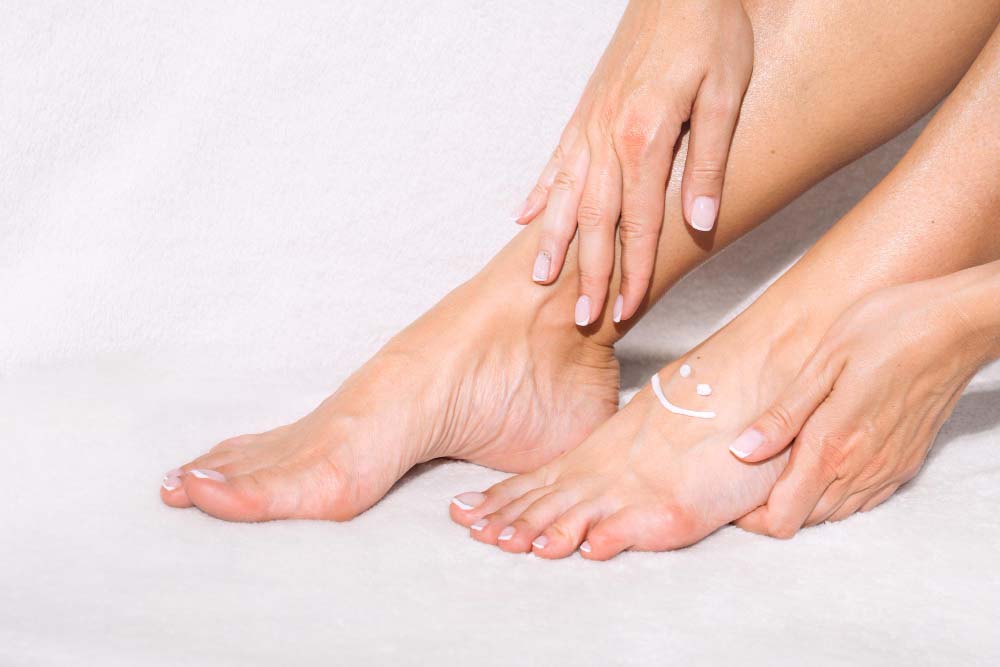
No high heels or flat shoes

– Which shoes should be worn to avoid flat feet?
– The shoes should have a stiff back, a firm and flexible sole and a small heel (about two centimetres). They shouldn't be too tight. If the heel is too high, the forefoot will be loaded, which can lead to transverse flatfoot. This can also result in bone growth. Of course, nothing bad can happen if you wear high heels on vacation. But wearing them systematically can have disastrous consequences. A few years ago England wanted to introduce a law banning the wearing of high heels. Because the dress code for office workers required them to wear heels, the country experienced a virtual epidemic of transverse flat feet. Not only the women suffered from this, but also the health insurance companies that paid for the treatment. Flat shoes should not be worn at all. If the shoes do not support the heel while walking, longitudinal flatfoot can develop.
– Is there a prevention against the development of flat feet?
- Children should be taught proper posture, effort and gait without overpronating their feet. Strengthen the arches of your feet with sensible exercise—skiing, biking, swimming, and walking two to five miles a day. If a child is predisposed to flat feet, sports that overload the foot, such as weightlifting or long-distance running, are not recommended. Competitive sport' unfortunately often leads to foot deformations. I advise everyone to do gymnastics and try to wear preventive footwear. There is a difference between prophylactic and orthopedic footwear. The latter are made for a specific deformity on doctor's prescription.
Surgery – as a last resort.
– What treatment is recommended by doctors?

– As a rule, one begins with conservative treatment – orthoses, exercise therapy and physical therapy are prescribed. Children rarely have surgery for flat feet. This is all the more true as the muscles that form the arch of the foot can strengthen as the child grows. Surgery can be done in adults, especially after the age of 40. Distortion of the arch of the foot can also lead to osteoarthritis. And that means constant foot pain under load, which severely impairs the quality of life.
– How safe is foot surgery?
– Overall, more than half of adults have some degree of flat feet. Not all need surgery. Surgery is only indicated in extreme cases. The foot is a complex organ with many joints and bones and has a complex function of providing support and cushioning when walking. Therefore, it is always a complex intervention and unfortunately not always successful. It's better not to go too far.
What is pronation?
Running puts more stress on your leg joints. When hitting a hard surface, the foot experiences a strong impact that is transmitted to the knees, hips and lower back. At this point, the natural cushioning mechanism kicks in and absorbs the force of the impact. The foot flattens out and the arch rotates inward. This correct positioning of the foot during movement is called pronation.
A distinction is made between hyperpronation, hypopronation and neutral pronation.
Hyperpronation is characterized by a large inward displacement of the arch of the foot. The longitudinal arch of the foot is reduced. Hyperpronation often accompanies flat feet. In hypopronation, the arch of the foot shifts outward as you move. Both tend to place the foot in a neutral position but do not provide adequate cushioning during movement, thus increasing the risk of injury. In neutral pronation, the natural cushioning mechanism works perfectly.
Answers to the most common questions about hyperpronation trainers
You can, but you need good cushioning. The standard insole can be replaced with a foot shaping insole.
Only for special foot development training and running technique. Regular cross-country skiing is best done in stable training shoes.
Yes. Hyperpronation trainers also allow you to run in neutral pronation if you are comfortable. Especially during long training sessions and marathons, when the foot loses stability due to fatigue.
Yes, you can put insoles in neutral sneakers if they are more comfortable than hyperpronator models.
The most common factors for flat feet related to a person's lifestyle are:
- Heredity: Underdevelopment of bones and connective tissue leads to it.
- overweight;
- work that requires you to be constantly on your feet;
- lack of exercise;
- Uncomfortable footwear: high heels and high heels, narrow toes;
- rickets, polio;
- Injuries, broken legs and injuries to the ankles, hocks, heel bones, etc.
Clubfoot is a very serious condition and can lead to crooked toes, blisters and corns.
Check out the early signs Changes in the foot can be recognized by the following symptoms:
- Pains;
- swelling, heaviness in the legs, cramps;
- Increased fatigue after walking;
- Deterioration of plastic ability when walking;
- enlargement of the bones of the big toe (callus);
- Worn shoes with an inward tilt.
For second grade the deformation becomes noticeable: the foot becomes flat, walking becomes difficult and the pain increases, which can radiate to the knee joints.
Most patients seek medical advice progressive flatfoot (grade III). They complain of pain and swelling in the lower limbs, headaches and pain in the lumbar region. They find it difficult to walk.
However, the symptoms of flat foot are characteristic of other diseases of the musculoskeletal system (varicose veins). Only after an examination and X-rays of the feet can the surgeon accurately diagnose the problem.
Treatment
Flat feet can only be fully treated at a young age when the bone skeleton is developing (up to the age of 12).
In adults, the goal of treatment is to slow down the development of severe forms of pathology and correct gait.
Pain-relieving drugs and physical therapy are often prescribed to the patient. Therapeutic exercises and massages, which together strengthen the muscles and ligaments of the feet and normalize blood circulation in the limbs, are helpful.
Average rating of 0 out of 5 based on 0 reviews
Third degree flat foot
Third degree flatfoot is characterized by an obvious external blemish that is visible to the naked eye in photographs and images of the foot. This form is known to cause prolonged pain and difficulty walking.
In addition, disc dislocations and progressive spinal disorders occur. Support can only be provided by special shoes, which are made after the impression of the foot on the advice of the orthopedist.
Do not be afraid that orthopedic shoes are unaesthetic - today's models are indistinguishable from ordinary shoes.
Image of shoes for flat feet
Which shoes for flat feet can not be worn?
Orthopedists categorically reject many of the models that exist:
- the sole is thick and hardly flexes (the load is not even, which weakens muscles and ligaments).
- The heel is too high. (By shifting the center of gravity to the base of the toe, a valgus deformation of the big toe and the formation of a bony prominence is possible there).
- Full soles in the form of a wedge heel or on a high plateau (reduced stability, prevents the foot from bending).
- Tight, tight shoes (the musculoskeletal system is not involved in walking, becomes increasingly weak and can no longer fulfill its function).
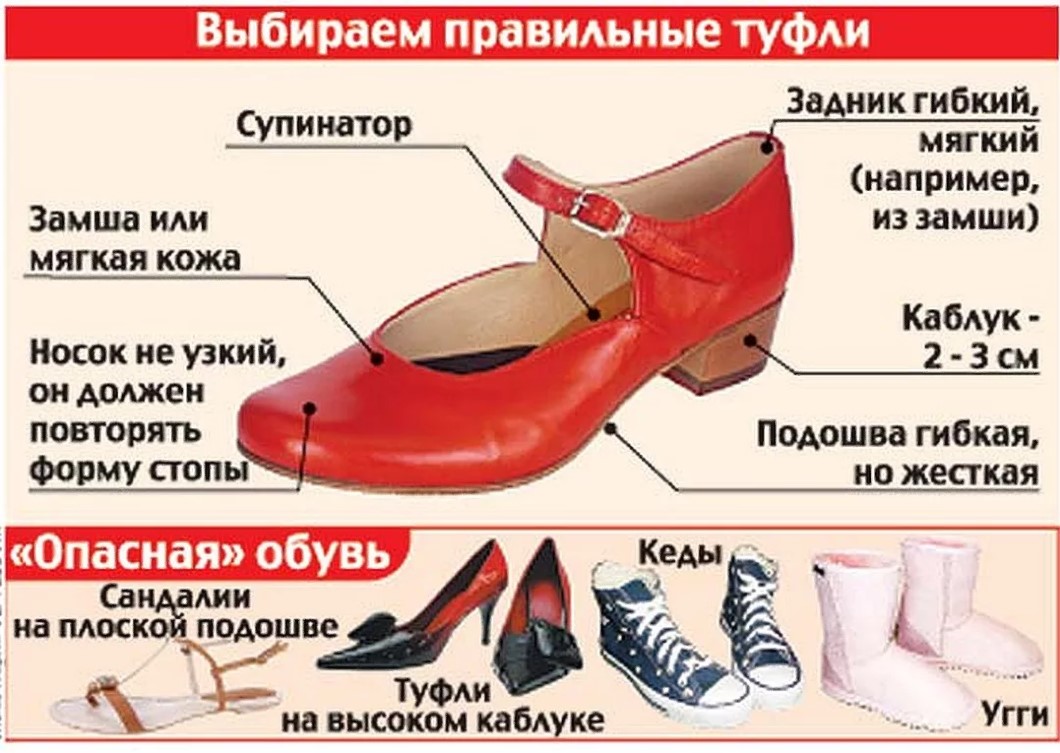
So, like any other disease, flat feet require prevention. It's not that difficult. It is enough to wear comfortable shoes every day and save the stilettos for formal occasions.
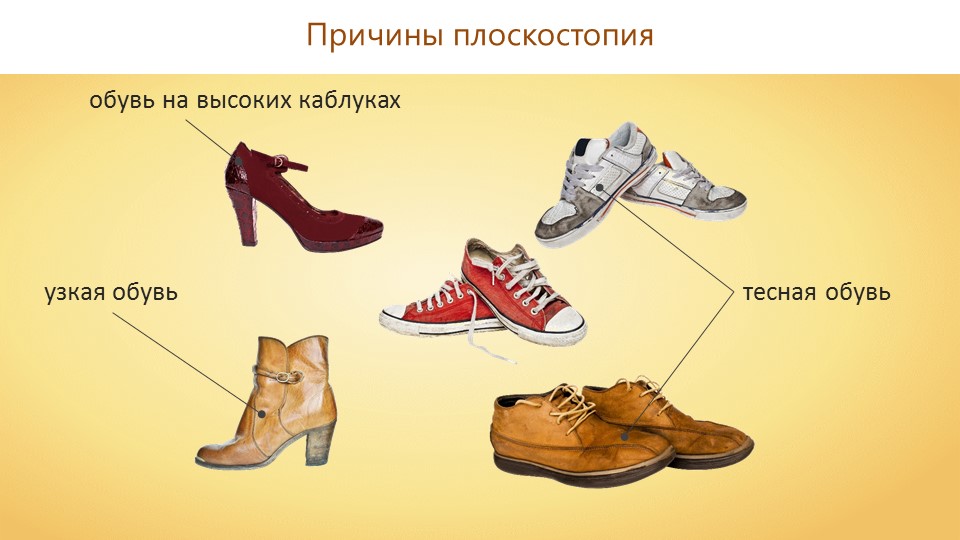
In both men and women, practicality should never be neglected. However, in today's world, flat feet are no excuse for just wearing 'granny' shoes. The fashion magazines are full of models that meet all the requirements mentioned here.
Comfortable women's shoe models for all seasons
Shoes for the summer season
The most comfortable shoes for women in the summer season are sandals or sandals with a low heel or wedge heel. A very important selection criterion is the width of the instep, which is intended to support the arch of the foot.
Would you like to stand a few centimeters higher? Then plateau models are a good choice. Pay special attention to the transition from forefoot to heel. It should be flowing (not too high, but not too flat either).
Low-heeled leather or suede ankle boots or mesh sneakers (available from almost all athletic shoe manufacturers) are also popular this time of year.
Sneakers, ballerinas or slippers are not recommended. They can be very comfortable, but due to their flat sole, they have a negative impact on the ankle and the articular apparatus of the foot. If you like the shoes very much, but their sole is absolutely flat, you can attach various orthopedic aids, e.g. B. Insoles, outsoles, silicone supinators (these are essential for arch support).
12 studios in Moscow, St. Petersburg and Tula
Quality service with a 7-day guarantee
Regular promotions and gifts for customers
If you choose a model with a very narrow toe, you should use silicone spacers or ball pads to avoid deforming the big toe.
Seasonal Shoes 'Demi'
For the transition between seasons, the following models are best suited:
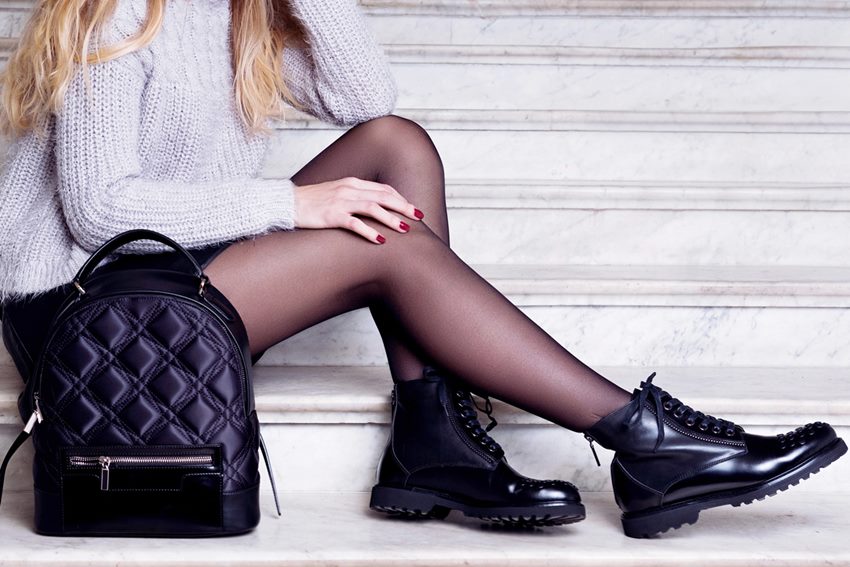
- loafers. These are comfortable and fashionable shoes without laces or buckles with a stable small heel.
- moccasins. Soft shoes that hug the foot snugly.
- Topsider. Originally intended as footwear for seafarers. They have a white sole that is non-slip. There is a lace on the heel of the shoe for better fixation. They are usually worn barefoot.
- Oxfords. The classic, beautiful model. These are closed shoes with laces.
- monks. Shoes that do not have laces and are instead fastened with buckles.
The most comfortable shoes for women for every occasion.
For sports activities.
The main purpose of athletic shoes is to keep the foot stable during exercise. Athletes need to focus on their training. The shoes should not be distracting or cause discomfort. Every sport puts a different strain on the foot.
Therefore, it is very important to take this criterion into account when choosing sports shoes. High sneakers, for example, are suitable for fitness. They give the ankle a secure hold and thus reduce the risk of injury. If you prefer strength training, choose low-top models with stiffer and firmer soles and back pads.
For jogging you should wear light and soft shoes. They are usually padded, have a relatively large heel and a rounded toe. It's a good idea to have an air cushion in the sole. It makes the cushioning even better and protects the ligaments and joints from excessive stress during sports. If you are looking for good sports shoes, you should not skimp.
Choose products from brands that are known and trusted by athletes and ordinary people. They last much longer and do not cause any inconvenience.
There is a wide range of shoes for athletes, including all-rounders. However, it is not recommended to wear them all the time because they do not meet the comfort criteria for the different sports.
For long walks
When walking, the foot is loaded from two directions: in the heel area (when hitting the ground) and on the ball of the foot (when walking forward). Therefore, it is very important that hiking shoes have a well-cushioned sole, an air exchange system, a stiff back and a slightly sloping heel. At the same time, they have to be light.
Versatile models are suitable for everyday walks, outdoor activities, simple physical education classes or activities that are not too dynamic. They can be sporty or casual. In the second case, a large selection and design for every taste will help.
Loafers and flat sandals: relief for swollen feet
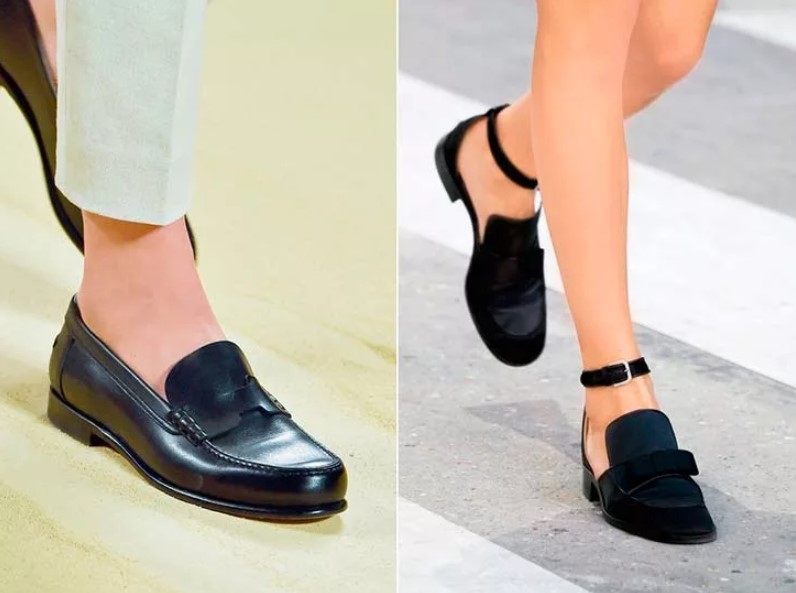
Loafers are modern and fashionable shoes that are suitable for women who often have swollen feet. You can't skimp on shoes, so you'll need to buy loafers or sandals. They should be made of light-colored leather so that the natural material adapts to the shape of the foot over time. The cut allows you to lock your feet in place, keeping you comfortable throughout the day.
On hot summer days, loafers can be replaced with sandals. Versatile models that can be combined with any outfit, any accessory and any style help against swelling. All you have to do is pick a pair for you.
Orthopedic shoes for flat feet can be divided into the following groups:
Outwardly, orthopedic shoes for flat feet look as stylish and familiar as any, but the design features provide the necessary cushioning, improve blood circulation, correct posture and evenly distribute the load on the sole. The construction includes the following important elements:
- Insole, pad, cushioning insole and toe separator - they all fix the arch of the foot in the right position. Depending on the combination of these elements, there are shoes for transverse, longitudinal or mixed flat feet;
- a firm and light sole with a curved forefoot;
- a stiff heel;
- small, stable heel;
- hard toes;
- High-quality materials - genuine leather, suede and nubuck - prevent the accumulation of moisture and allow the skin to 'breathe';
- tight fit.
Orthopedic shoes for flat feet resemble a kind of 'corset for the foot', which ensures that the foot is fixed in the physiologically correct position, increasing the contact surface and thus reducing pain and reducing fatigue when walking.
Indications for use
In addition to the obvious indications of various degrees of flat feet, it is recommended to consider prophylactic orthopedic footwear for people who are at risk of developing this pathology: children, pregnant women, the elderly, obese, office workers and groups of people with a sedentary lifestyle, Professions that require long periods of walking and standing (hairdressers, waiters, shop assistants, etc.).
Products for people with severe flat feet are made based on a referral from an orthopedist. It is important to remember that in the early stages of the disease and the need for prevention, many people are equipped with universal models, but in some cases they need orthoses made to individual measurements. Orthopedic shoes should be adjusted to the right size.
To make a purchase, simply add your favorite items to the shopping cart and fill out the form with your contact details or contact us in the most convenient way for you in the 'Contact Us' section. Our specialists will help you arrange payment and delivery and provide you with all product information.
Read more:- How to determine the type of pronation.
- What is pronation and supination?.
- pronation and supination.
- Pronation and supination in anatomy.
- pronation.
- Optimal heel height for women.
- Sneakers with hyperpronation.
- These are the pronator muscles.
